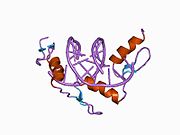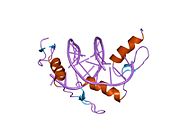EGR2
Ensembl | |||||||||
|---|---|---|---|---|---|---|---|---|---|
| UniProt | |||||||||
| RefSeq (mRNA) | |||||||||
| RefSeq (protein) |
| ||||||||
| Location (UCSC) | Chr 10: 62.81 – 62.82 Mb | Chr 10: 67.54 – 67.54 Mb | |||||||
| PubMed search | [3] | [4] | |||||||
| View/Edit Human | View/Edit Mouse |
Early growth response protein 2 is a protein that in humans is encoded by the EGR2 gene. EGR2 (also termed Krox20) is a transcription regulatory factor, containing three zinc finger DNA-binding sites, and is highly expressed in a population of migrating neural crest cells.[5][6][7] It is later expressed in the neural crest derived cells of the cranial ganglion. The protein encoded by Krox20 contains two cys2his2-type zinc fingers. Krox20 gene expression is restricted to the early hindbrain development.[6][8] It is evolutionarily conserved in vertebrates, humans, mice, chicks, and zebra fish.[9] In addition, the amino acid sequence and most aspects of the embryonic gene pattern is conserved among vertebrates, further implicating its role in hindbrain development.[7][10][11][12] When the Krox20 is deleted in mice, the protein coding ability of the Krox20 gene (including the DNA-binding domain of the zinc finger) is diminished. These mice are unable to survive after birth and exhibit major hindbrain defects.[6][8] These defects include but are not limited to defects in formation of cranial sensory ganglia, partial fusion of the trigeminal nerve (V) with the facial (VII) and auditory (VII) nerves, the proximal nerve roots coming off of these ganglia were disorganized and intertwined among one another as they entered the brainstem, and there was fusion of the glossopharyngeal (IX) nerve complex.[13][14][15]
Function
The early growth response protein 2 is a transcription factor with three tandem C2H2-type zinc fingers. Mutations in this gene are associated with the autosomal dominant
New research suggests that Krox20 - or the lack of it - is the reason for male baldness.[21]
References
- ^ a b c GRCh38: Ensembl release 89: ENSG00000122877 – Ensembl, May 2017
- ^ a b c GRCm38: Ensembl release 89: ENSMUSG00000037868 – Ensembl, May 2017
- ^ "Human PubMed Reference:". National Center for Biotechnology Information, U.S. National Library of Medicine.
- ^ "Mouse PubMed Reference:". National Center for Biotechnology Information, U.S. National Library of Medicine.
- PMID 2496302.
- ^ PMID 8224839.
- ^ S2CID 4336310.
- ^ S2CID 20347966.
- PMID 1317498.
- S2CID 4324322.
- S2CID 4312466.
- PMID 8464695.
- PMID 1983472.
- S2CID 4371764.
- PMID 1688180.
- ^ "Entrez Gene: EGR2 early growth response 2 (Krox-20 homolog, Drosophila)".
- S2CID 32746701.
- S2CID 25550479.
- PMID 23720781.
- PMID 26214589.
- ^ Le, Lu. "Scientists find skin cells at the root of balding, gray hair". UT Southwestern Medical Center. Retrieved 9 May 2017.
Further reading
- Rangnekar VM, Aplin AC, Sukhatme VP (May 1990). "The serum and TPA responsive promoter and intron-exon structure of EGR2, a human early growth response gene encoding a zinc finger protein". Nucleic Acids Research. 18 (9): 2749–57. PMID 2111009.
- Chavrier P, Janssen-Timmen U, Mattéi MG, Zerial M, Bravo R, Charnay P (February 1989). "Structure, chromosome location, and expression of the mouse zinc finger gene Krox-20: multiple gene products and coregulation with the proto-oncogene c-fos". Molecular and Cellular Biology. 9 (2): 787–97. PMID 2496302.
- Joseph LJ, Le Beau MM, Jamieson GA, Acharya S, Shows TB, Rowley JD, Sukhatme VP (October 1988). "Molecular cloning, sequencing, and mapping of EGR2, a human early growth response gene encoding a protein with "zinc-binding finger" structure". Proceedings of the National Academy of Sciences of the United States of America. 85 (19): 7164–8. PMID 3140236.
- Topilko P, Schneider-Maunoury S, Levi G, Baron-Van Evercooren A, Chennoufi AB, Seitanidou T, Babinet C, Charnay P (October 1994). "Krox-20 controls myelination in the peripheral nervous system". Nature. 371 (6500): 796–9. S2CID 4333028.
- Sham MH, Vesque C, Nonchev S, Marshall H, Frain M, Gupta RD, Whiting J, Wilkinson D, Charnay P, Krumlauf R (January 1993). "The zinc finger gene Krox20 regulates HoxB2 (Hox2.8) during hindbrain segmentation". Cell. 72 (2): 183–96. S2CID 3205209.
- Levi G, Topilko P, Schneider-Maunoury S, Lasagna M, Mantero S, Pesce B, Ghersi G, Cancedda R, Charnay P (June 1996). "Role of Krox-20 in endochondral bone formation". Annals of the New York Academy of Sciences. 785 (1): 288–91. S2CID 27761983.
- Warner LE, Mancias P, Butler IJ, McDonald CM, Keppen L, Koob KG, Lupski JR (April 1998). "Mutations in the early growth response 2 (EGR2) gene are associated with hereditary myelinopathies". Nature Genetics. 18 (4): 382–4. S2CID 25550479.
- Warner LE, Svaren J, Milbrandt J, Lupski JR (July 1999). "Functional consequences of mutations in the early growth response 2 gene (EGR2) correlate with severity of human myelinopathies". Human Molecular Genetics. 8 (7): 1245–51. PMID 10369870.
- Timmerman V, De Jonghe P, Ceuterick C, De Vriendt E, Löfgren A, Nelis E, Warner LE, Lupski JR, Martin JJ, Van Broeckhoven C (June 1999). "Novel missense mutation in the early growth response 2 gene associated with Dejerine-Sottas syndrome phenotype". Neurology. 52 (9): 1827–32. S2CID 11569651.
- Bellone E, Di Maria E, Soriani S, Varese A, Doria LL, Ajmar F, Mandich P (October 1999). "A novel mutation (D305V) in the early growth response 2 gene is associated with severe Charcot-Marie-Tooth type 1 disease". Human Mutation. 14 (4): 353–4. S2CID 85039222.
- Pareyson D, Taroni F, Botti S, Morbin M, Baratta S, Lauria G, Ciano C, Sghirlanzoni A (April 2000). "Cranial nerve involvement in CMT disease type 1 due to early growth response 2 gene mutation". Neurology. 54 (8): 1696–8. S2CID 28404231.
- Gambardella L, Schneider-Maunoury S, Voiculescu O, Charnay P, Barrandon Y (September 2000). "Pattern of expression of the transcription factor Krox-20 in mouse hair follicle". Mechanisms of Development. 96 (2): 215–8. S2CID 18000564.
- Yoshihara T, Kanda F, Yamamoto M, Ishihara H, Misu K, Hattori N, Chihara K, Sobue G (March 2001). "A novel missense mutation in the early growth response 2 gene associated with late-onset Charcot--Marie--Tooth disease type 1". Journal of the Neurological Sciences. 184 (2): 149–53. S2CID 19693658.
- Boerkoel CF, Takashima H, Bacino CA, Daentl D, Lupski JR (July 2001). "EGR2 mutation R359W causes a spectrum of Dejerine-Sottas neuropathy". Neurogenetics. 3 (3): 153–7. S2CID 32746701.
- Yang Y, Dong B, Mittelstadt PR, Xiao H, Ashwell JD (May 2002). "HIV Tat binds Egr proteins and enhances Egr-dependent transactivation of the Fas ligand promoter". The Journal of Biological Chemistry. 277 (22): 19482–7. PMID 11909874.
- Vandenberghe N, Upadhyaya M, Gatignol A, Boutrand L, Boucherat M, Chazot G, Vandenberghe A, Latour P (December 2002). "Frequency of mutations in the early growth response 2 gene associated with peripheral demyelinating neuropathies". Journal of Medical Genetics. 39 (12): 81e–81. PMID 12471219.
- Musso M, Balestra P, Taroni F, Bellone E, Mandich P (February 2003). "Different consequences of EGR2 mutants on the transactivation of human Cx32 promoter". Neurobiology of Disease. 12 (1): 89–95. S2CID 29600641.
- Unoki M, Nakamura Y (April 2003). "EGR2 induces apoptosis in various cancer cell lines by direct transactivation of BNIP3L and BAK". Oncogene. 22 (14): 2172–85. PMID 12687019.
- Numakura C, Shirahata E, Yamashita S, Kanai M, Kijima K, Matsuki T, Hayasaka K (June 2003). "Screening of the early growth response 2 gene in Japanese patients with Charcot-Marie-Tooth disease type 1". Journal of the Neurological Sciences. 210 (1–2): 61–4. S2CID 36723641.
External links
- GeneReviews/NCBI/NIH/UW entry on Charcot-Marie-Tooth Neuropathy Type 1
- GeneReviews/NCBI/NIH/UW entry on Charcot-Marie-Tooth Neuropathy Type 4
- EGR2+protein,+human at the U.S. National Library of Medicine Medical Subject Headings (MeSH)
This article incorporates text from the United States National Library of Medicine, which is in the public domain.









